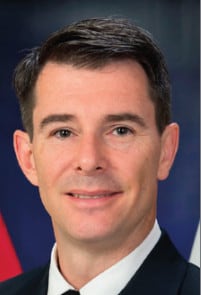Dr. Scott Williams notes the patient’s quality of care is linked to the ability of the referring sleep physician and his clinic to communicate their plan to the entire care team.
 by Scott Williams, MD
by Scott Williams, MD
Sleep medicine is a highly collaborative and multi-disciplinary field. There are few medical specialties that allow Internists, Psychiatrists, Family Physicians, Otolaryngologists, Pulmonologists, Pediatricians, Neurologists and Dentists all to work together to solve specific patient complaints. We are also very proud to have highly skilled Sleep Technologists, Respiratory Therapists, Durable Medical Equipment experts, and a vast array of support personnel to assist. With that collaboration comes challenges, though, and the quality of the care is inextricably linked to the ability of the sleep clinic to communicate the plan of care to the entire care team. One of the most significant topics at the physician-dentist interface is the determination of how well a mandibular advancement device (MAD) is working, and when it is appropriate to order a MAD titration polysomnogram.
In recent weeks, I have been fortunate to work with the American Academy of Dental Sleep Medicine (AADSM) on their Referral Efficacy Task Force. In this endeavor, we are creating some easy to use products for Dental Sleep Medicine (DSM) specialists to determine when the patient is ready to be sent back to the physician for confirmation of treatment efficacy and quantify patient improvement. These documents are intended to be shared with the referring sleep physician’s office, and should provide some standardization across the country. In addition, this task force is developing guidelines for the AADSM to guide dentists when to refer the patient back to the sleep physician. The AADSM Board of Directors will approve and make these materials available to members within the next few months.
A quick phone call between the medical and dental clinics will go a long way to improving outcomes for these patients.
The first step in the workflow is to determine whether the patient has returned for follow-up DSM visits. The AADSM wants to make it clear, especially to patients, that this step should not be rushed. The patient should use a MAD for a couple of months* before evaluating the overall efficacy. This timeline is important for physicians to convey to patients who might be looking for a “quick fix.” It is critical for the sleep physician to discuss the relative timelines and milestones of MAD and CPAP prior to placing a DME order or referring to DSM experts. MAD therapy is very labor intensive up front, but once successfully delivered and adjusted, a MAD is much easier to maintain than CPAP. These differences must be communicated to patients at every appointment to ensure expectation management and optimize adherence.
The second step is for the DSM specialist to determine patient’s adherence. Whereas the minimum CPAP adherence is typically >4 hours per night at least 70% of nights, the AADSM defines MAD adherence as requiring use 80% of nights at least 5 nights per week. There are commercially available adherence monitoring devices, but often we rely on patient self-report. The dentist will provide initial troubleshooting if adherence is sub-optimal, but this is an area where close communication is critical in case there are other aspects of care that the medical provider can treat.
Once adherence is established, the dentist will assess overall subjective response to treatment as a third step. The AADSM is creating a Verification of Treatment Efficacy form, and can be used to provide feedback to the medical clinic. If the patient is reporting problems with treatment, the dentist will provide initial troubleshooting. This is another step where close coordination is important because patients early in the treatment are at risk for discontinuing therapy if they perceive it not to be value added. A quick phone call between the medical and dental clinics will go a long way to improving outcomes for these patients.
Finally, the fourth step is to refer the patient back for a titration study. Many patients are lost to follow-up at this point, even if they feel well, because they may not want another PSG. Once again, close coordination between medical and dental professionals can ensure that a consistent message reaches the patient. It is common for a patient to be partially treated and when the MAD titration study is performed, even greater improvements in subjective and objective response are realized. In order for the PSG to be as useful as possible, it is recommended that the dental clinic meet with the sleep technologist to review the types of devices that they prescribe, and to make sure the overnight staff are comfortable adjusting it. An instructional paper is acceptable, but when possible an in-service allows for interactive teaching and is preferred.
While the above may seem simple, they will no doubt result in markedly improved responses to therapy.
*The suggested timeframe is currently under review with the AADSM.
In this column, “In Your Own Words,” dentists share their best practices for developing and maintaining relationships with the referring sleep physician: https://dentalsleeppractice.com/in-your-own-words-2/


 Lieutenant Colonel Scott Williams, MD, is the director for Military Psychiatry and Neuroscience at the Walter Reed Army Institute of Research. LTC Williams was born in Bournemouth, England and was raised in Princeton, New Jersey. He graduated and was commissioned into the U.S. Army from The University of North Carolina at Chapel Hill in 2000. LTC Williams received his medical doctorate from the Uniformed Services University of the Health Sciences in 2004. He completed a dual residency in Internal Medicine and Psychiatry at the Walter Reed Army Medical Center in 2009. He completed fellowship training in Sleep Disorders Medicine at the Walter Reed National Military Medical Center in 2012. Upon graduation from fellowship, Dr. Williams assumed duties as Chief of Sleep Medicine at Womack Army Medical Center. While there he served on the AASM Education Committee and obtained an academic appointment as assistant professor of medicine at USUHS, later rising to the rank of associate professor of Medicine (primary) and Psychiatry (secondary). He increased his involvement with the AASM after returning to WRNMMC to take charge of the Sleep Disorders Center. He is now the chair of the Sleep Technologist and Respiratory Therapist Education Committee and is part of the gold standard panel for the Inter-Scorer Reliability program.
Lieutenant Colonel Scott Williams, MD, is the director for Military Psychiatry and Neuroscience at the Walter Reed Army Institute of Research. LTC Williams was born in Bournemouth, England and was raised in Princeton, New Jersey. He graduated and was commissioned into the U.S. Army from The University of North Carolina at Chapel Hill in 2000. LTC Williams received his medical doctorate from the Uniformed Services University of the Health Sciences in 2004. He completed a dual residency in Internal Medicine and Psychiatry at the Walter Reed Army Medical Center in 2009. He completed fellowship training in Sleep Disorders Medicine at the Walter Reed National Military Medical Center in 2012. Upon graduation from fellowship, Dr. Williams assumed duties as Chief of Sleep Medicine at Womack Army Medical Center. While there he served on the AASM Education Committee and obtained an academic appointment as assistant professor of medicine at USUHS, later rising to the rank of associate professor of Medicine (primary) and Psychiatry (secondary). He increased his involvement with the AASM after returning to WRNMMC to take charge of the Sleep Disorders Center. He is now the chair of the Sleep Technologist and Respiratory Therapist Education Committee and is part of the gold standard panel for the Inter-Scorer Reliability program.